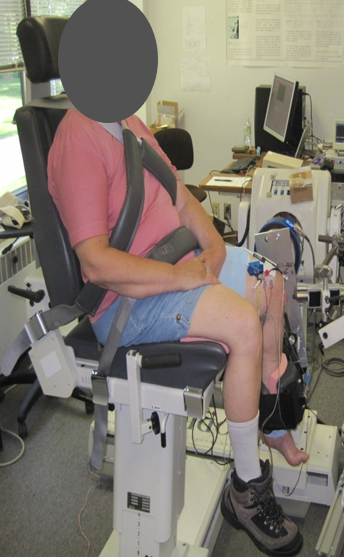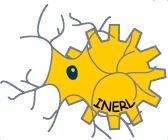-

This laboratory is centered around our Biodex dynamometer that has been modified with multiple six-axis load cells, which allow for force and torque measurement at multiple joints simultaneously. Our Biodex machine is coupled with a 16 channel electromyography (EMG) machine (Bortec Biomedical Ltd). Data from both the load cells and EMG system are collected by LabVIEW and a National Instruments data acquisition system. This equipment allows for multiple digital and analog input/output ports, in addition to the force, torque, and EMG signals. Our system is also complimented with a dual screen computer that can be programmed to give real time feedback to our subjects. Please take some time to read below about some of the ongoing projects in our Biodex Laboratory.
Neural mechanisms of arm stabilization post-stroke using tendon vibration
A recent study from our laboratory, in collaboration with Dr. Robert Scheidt, has shown that the application of vibration allows people who had suffered a stroke to better stabilize their hand in space. Subjects were asked to make point to point movements in a 2D workspace with a destabilizing force field and also track a figure eight pattern. With vibration applied to the wrist, the end point stability of their hand was increased and EMG activity decreased, especially in shoulder muscles (Conrad 2009, Conrad 2011).
After observing these results, we decided to try and locate at which neurological level this vibration phenomenon as occurring. For her master’s work, Bani Gadhoke has been working on a project that uses isometric contractions of the arm in the Biodex and tendon tapping to elicit and measure spinal reflexes. The goal of the project is to see if spinal reflexes are altered during volitional isometric contractions with vibration at the wrist. She has hypothesized that if there are changes to these reflexes then the vibratory effects are concentration at a spinal level. If not, however, it will be assumed that vibration is altering sensory signals at a higher level such as the brainstem or sensorimotor cortex.
Contributions of central neuromuscular fatigue post-stroke
A new project that is just getting underway is exploring the contribution of central mechanisms on muscular fatigue after someone has suffered a stroke. Henry Kuhnen has been working on his master’s thesis, in collaboration with Dr. Allison Hyngstrom and Dr. Sandra Hunter, to examine this neural phenomenon. Henry will be utilizing the Biodex system to control a fatiguing task where the subjects will be asked to complete repetitive knee extension isometric contractions. Fatigue will be continually monitored after a specific number of contractions using a maximal voluntary contraction (MVC) measure and the task will end when the MVC goes below a certain threshold. Subjects will do this protocol before and after the administration of 5-HT/NE reuptake inhibitor (SNRI). The administration of the SNRI should prolong a time to fatigue task in normal people. Henry hypothesizes that people who have suffered a stroke will not response to the SNRI, which would indicate an inability of motoneuron pools to respond to neuromodulatory inputs from the brainstem.
